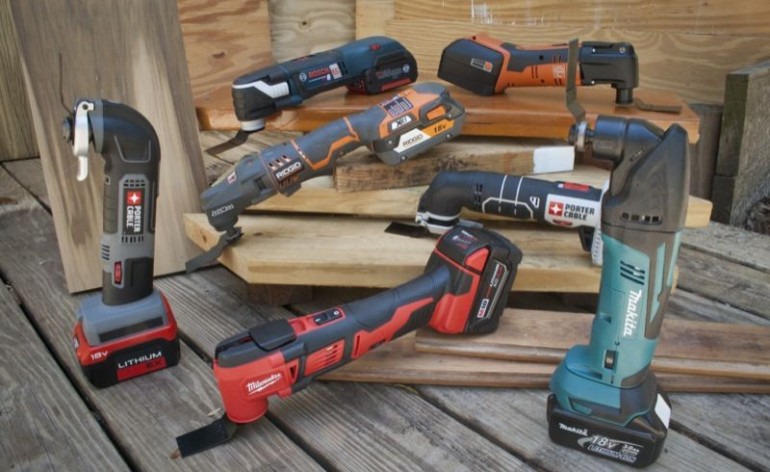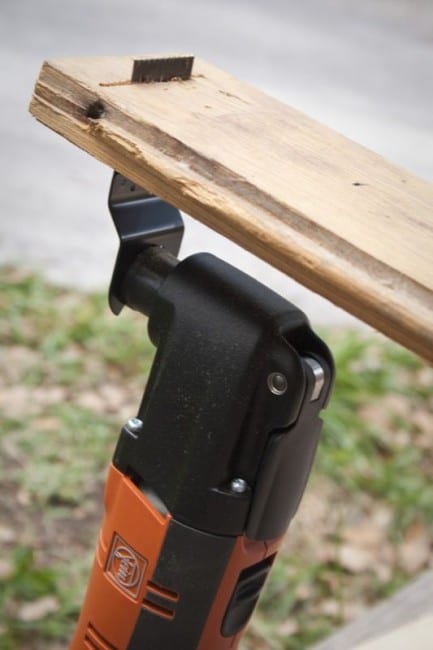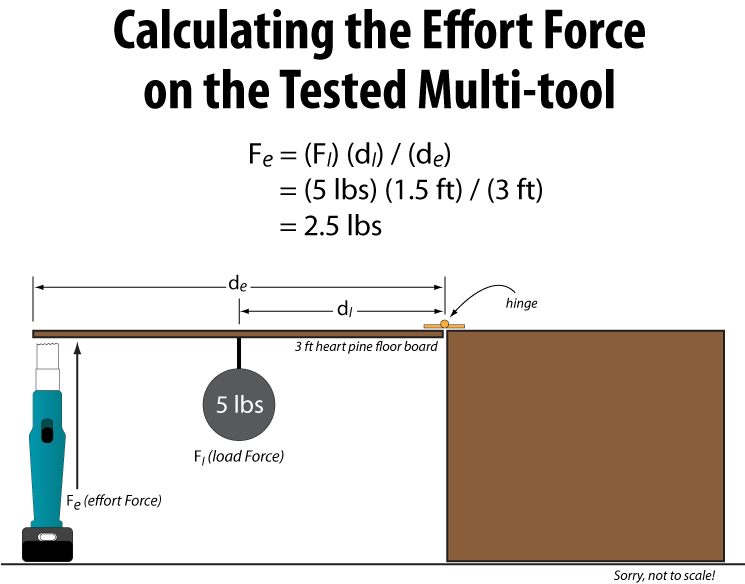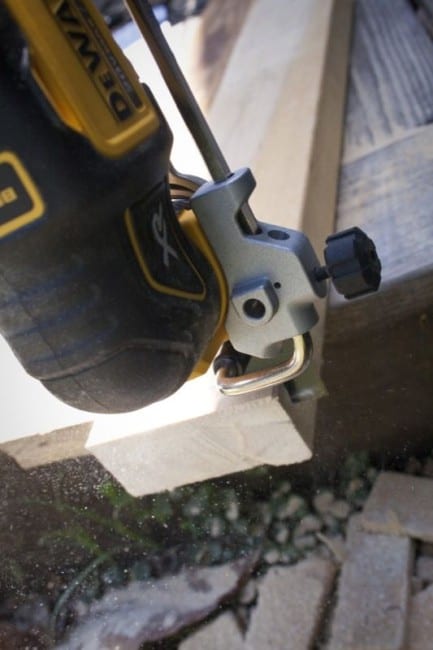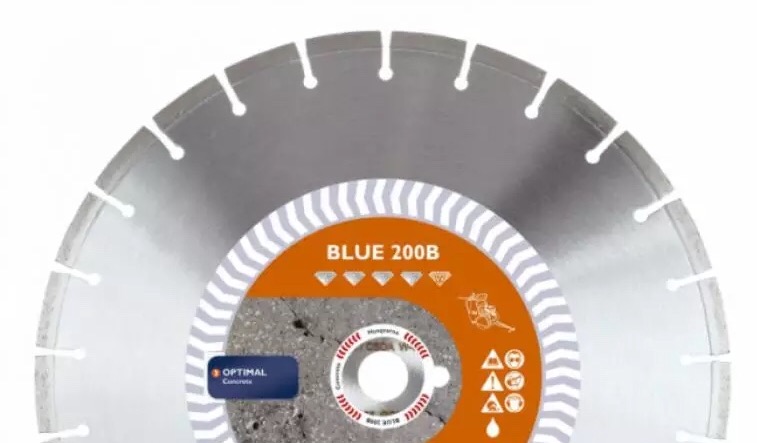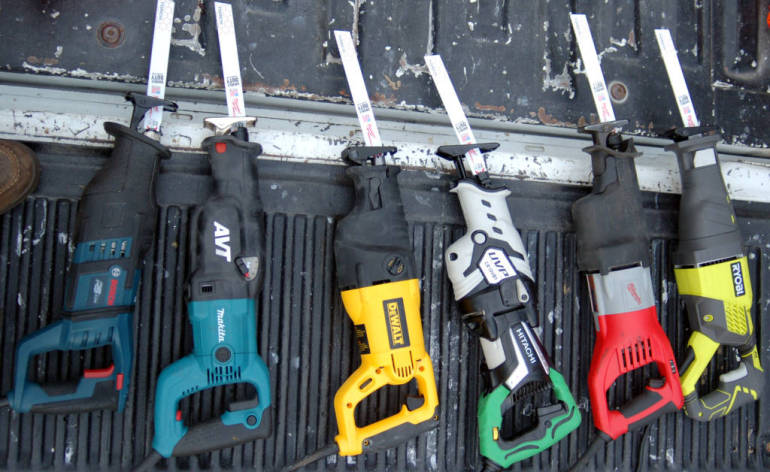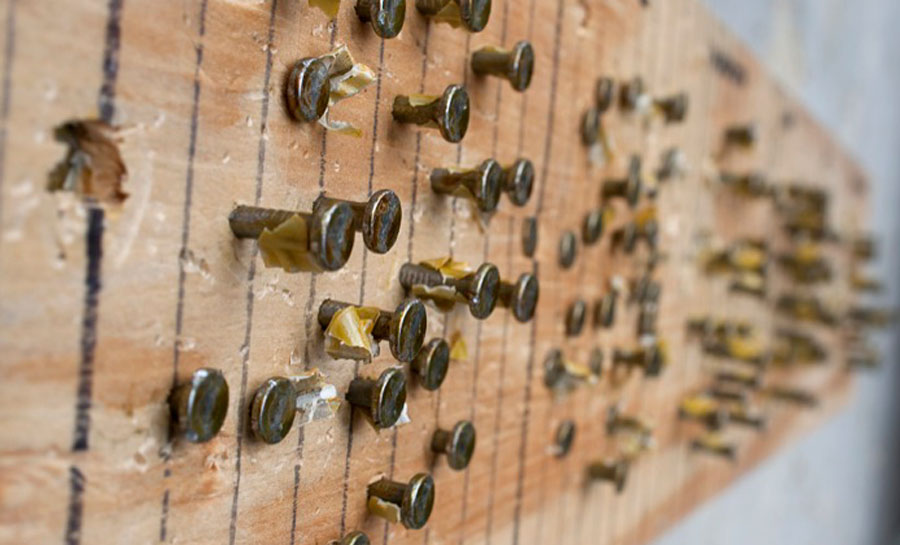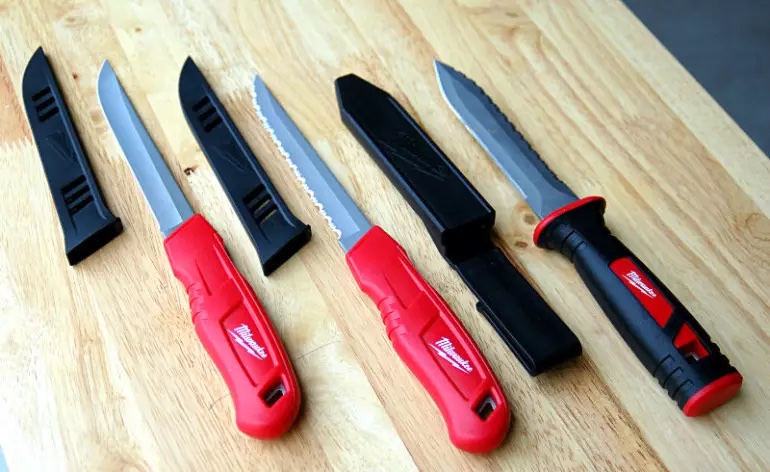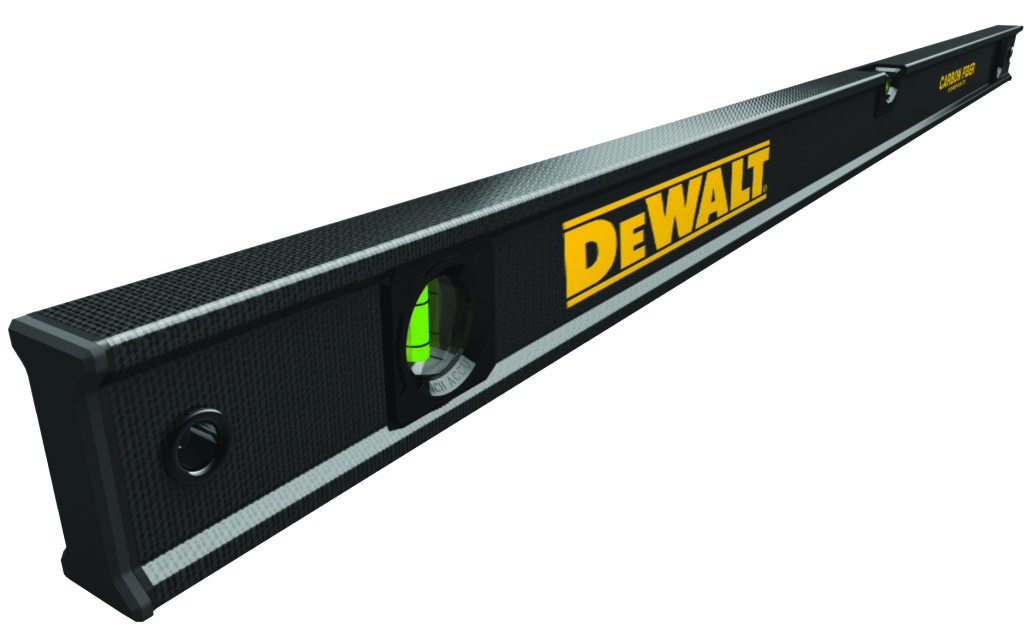The coolest tool in the world just got cooler
Ed's Note: This comprehensive tool review is reprinted with permission from ProToolReviews.com, a comprehensive tool review website, as the name infers. If you are a tool junkie, you should go there and dig through their ditches. There's a lot.
Pro Tool Reviews did its first corded oscillating multi tools comparison shootout back in 2009. It was one of our earliest comparison articles and remains popular with those looking to check out what’s available in the realm of corded multi-tools.
At the time, finding the best cordless oscillating multi-tool was a pipe dream—they were just hitting the market—and most models were 12V.
Today’s cordless multi-tools have come a long way, and the current crop of 18 volt (ish) models are more than a little impressive.
For starters, these new tools boast incredible run times. With most 12V cordless multi-tools, run-time was measured in the 10 minute range or less. Now, your full-size cordless oscillating multi-tool will easily deliver over a half-hour of work—on the low side.
I picked up the Bosch MXH180BL, Fein MultiMaster AFMM 14, Makita LXMT025, Milwaukee 2626-22, Porter-Cable PCCK510LA, Porter-Cable PCC710, Ridgid JobMax R862004, and the DeWalt DCS355D1 to run through the paces.
Finding the best cordless oscillating multi-tools today is important for a variety of reasons. First—there’s nothing quite like them. When you need a cordless multi-tool, it’s likely because nothing else will do the job.
That could be cutting into a pipe that doesn’t have a lot of lateral clearance, slicing a vertical cut into a piece of baseboard moulding, or my favorite—undercutting door jambs. I’ve cut dozens of door jambs out in the course of laying tile or wood flooring, and the oscillating multi-tool is always my go-to tool for this type of work.
It’s so significantly better at it than any manual or other power saw type that I’d happily go pick up a new multi-tool if I were in the middle of a job and my tool gave out. Doing it any other way is simply not worth the hassle.
The tools in this roundup have similar features, but also several unique details.
- They’re all 18V (nominal) models with the exception of the Fein MultiMaster, which is 14.4 (but certainly holds its own weight).
- Excepting the Bosch MXH180BL and the Fein Multimaster, all of the tools include a handy LED to illuminate the work area.
- Most of the tools also come in kits, but Ridgid’s JobMax and Porter-Cable’s 20V Max tools currently only fly solo, allowing you to add them into your collection at a much lower cost of entry.
Test 1: Best Cordless Oscillating Multi-tools for Hard Wood Cutting
There’s nothing quite like plunge-cutting into hardwood floors. When you need to cut out a floor register, or cut in an area to replace with plywood for laying tile, an oscillating multi-tool is a very handy tool to have around.
The problem is, with older floors—the kind I most often run into—you’re dealing with heart pine or even oak which presents a significant cutting challenge if you’re doing more than just punching out a couple of slots.
For this test I grabbed some pieces of 90-year-old heart pine flooring and went to work to discover which model would be the best cordless oscillating multi-tool in this category.
The Testing System
Building a testing methodology that’s fair and effective is no small challenge. You have to ensure that your setup is designed to test the tool and not the accessory.
After a few jobs you’re going to have to go shopping for a blade, and so a tool review based on the included blade is all but worthless if you want to know about the actual tool’s performance.
For these tests I used Porter-Cable blades. While not stellar in terms of quality, they were OIS-compatible and allowed us to test all of the tools without having to insert any adapters.
What this means is that you can expect even better performance all around if you take our tests and results and substitute a superior quality accessory blade.
In order for these hard wood tests to be accurate and repeatable, a system was needed that would deliver consistent force to the blade—a system that was better than just using your hands.
To accomplish this, I built a class 3 lever system with the help of fellow-reviewer David Delk. With a sturdy base and fulcrum on one side, and a five pound weight in the middle, we drove the end of a 3/4-inch thick heart pine board into the blade of the secured multi-tool with 2.5 lbs. of effort force (see diagram).
The result was a consistent, repeatable test that could be executed over and over again to average the results.
The test was simple: Which tool could plunge-cut through the ancient knot-free heart-pine board the fastest? Each test was run three times per tool, and a stopwatch was used to keep score for each test during each round. At the end we averaged the results and recorded them in our table.
The Results
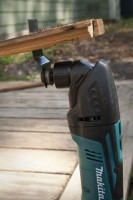 I had high expectations that the Fein would do very well in this test. I have a good amount of experience with that tool.
I had high expectations that the Fein would do very well in this test. I have a good amount of experience with that tool.
What I didn’t expect was that it would be bested by the Makita—which turned out to be the stealthy star player over and over again (keep reading).
Most of the tools fell into the middle range, from 11-13 seconds. The two tools on the bottom end were the 20V Max Porter-Cable PCC710 and the DeWalt DCS355. The PCC710 took an astoundingly long 68.7 seconds on average to plunge cut our board—a fact we attributed to its tendency to lose lateral movement ability when encountering a significant load. That reduced the cutting capacity of the tool.
(We also retested it with different blades to ensure it wasn’t the accessory.)
A lot of tools in the middle range had been recorded when the Makita came up for testing, so imagine my surprise when it chewed through our board in just 8 seconds flat! I wasn’t convinced it hadn’t just hit a soft part of wood until I reset the test and ran it two more times.
Its excellent score, in fact, caused us to retest all the tools—but the results didn’t change.
In evaluating why some tools were better at cutting than others, it was difficult to come up with a clear reason. At first I thought vibration might be the culprit—as, for the most part, the smoother tools performed better. Another more obvious connection would be the oscillating angle. The Makita LXMT025 has an additional .2 degrees of swing over most other tools (the DeWalt shares this) which could be enough to cut more aggressively through material.
Also, the tool’s ability to maintain that angle of movement even when plunge-cutting into hard wood (similar to a drill maintaining its maximum torque under load) seemed to be a related factor.
Test 2: Best Cordless Oscillating Multi-tools for Metal Cutting
Having already tested corded oscillating multi-tools, I knew that there’s nothing quite like plunge-cutting into hardwood floors. When you need to cut out piece of material that may have embedded nails, however, it’s good to know that your tool can handle the job.
We decided to test the tools with identical wood/metal blades on slicing through two sequential 16D galvanized nails driven into a test board. It required a bit of setup, but it did an adequate job of revealing the tool’s ability to handle metal encountered in the course of executing a cut.
We did these tests with brand-new blades using a hand-held method because it’s nearly impossible on a small diameter nail to eliminate the counteracting vibrations caused by the workpiece. In the end, I believe our test configuration was more than adequate for comparing the tools in a more apples-to-apples faceoff.
Overall, the nail added roughly 15-20 seconds to the cut on average, which also matched up with our experiences using the tool freehand to cut standing galvanized nails.
Remember that plunge cuts like this are almost always going to be faster when you are varying the cutting angle and when you keep the blade in motion. Our testing involved a static tool position with only 2.5 pounds of downward force to the blade.
Test 3: Best Cordless Oscillating Multi-tools for Ergonomics
I still had some more objective tests to run, but handling the tools is another big part of what makes for the best cordless oscillating multi-tools.
Vibration reduction is a big deal on tools like this and it was very clear who had it and who didn’t seem to prioritize that in the development process.
We tested vibration mostly by handling the tools and giving a subjective opinion, but I also performed a “pepper” test—sprinkling pepper onto a white piece of paper and watching the results as I set the tool down while running (a test I was unable to perform on the DeWalt or the Ridgid due to how they operate via trigger).
 The Porter-Cable 20V PCC710 and the DeWalt DCS355 both had a ton of vibration (and were two of the louder, higher-pitched tools in the roundup).
The Porter-Cable 20V PCC710 and the DeWalt DCS355 both had a ton of vibration (and were two of the louder, higher-pitched tools in the roundup).
On the PCC710, I liked how you could choke up in the head of the tool and really maneuver it. It almost felt like a barrel-grip jigsaw. This was mostly due to locating the power button at the base of the tool (which was a tad awkward).
I liked being able to stand the DeWalt, Makita and Porter-Cable models vertically, though the 18V Porter-Cable had a significant amount of weight toward the rear of the tool that kept it off-balance.
The Milwaukee, Fein, Ridgid and Bosch had almost perfect balance and poise, though the Bosch is unbelievably squarish in shape and a bit unwieldy unless you have huge hands.
All of the 18V oscillating multi-tools had an integrated LED light with the exception of both the Bosch and Fein models.
Also, while the Ridgid JobMax technically had an LED, it is much more optimized for the tool’s driving heads and throws considerable shadows when using the multi-tool and a cutting accessory.
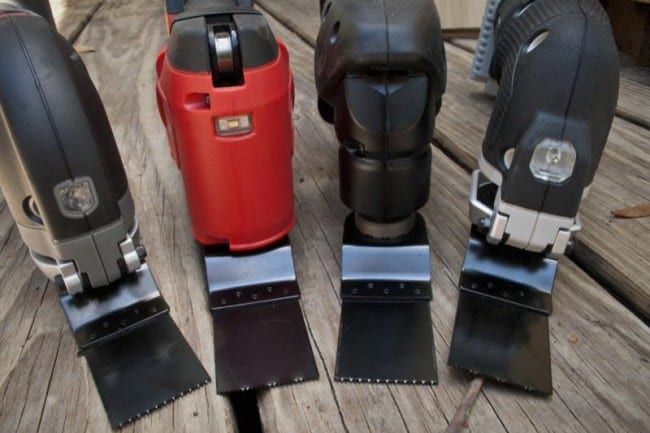
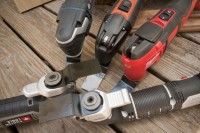 Of the best cordless oscillating multi-tools tested, only the Ridgid and the Makita required a tool to change out an accessory. Makita was at least thoughtful enough to provide on-tool storage of the Allen wrench.
Of the best cordless oscillating multi-tools tested, only the Ridgid and the Makita required a tool to change out an accessory. Makita was at least thoughtful enough to provide on-tool storage of the Allen wrench.
Of the tool-less models, the Fein took a while to get used to, but once I did, I actually liked how the system worked—particularly because it didn’t require any threading.
The Bosch MXH180BL is hands-down the easiest to use and could run circles around any of the other tools in ease of changing accessories.
Milwaukee’s 2626-20 is simple to use, but it does require unthreading the center post for three full revolutions before you can pull it out and replace the accessory.
The DeWalt and Porter-Cable models are very simple clamping-style mechanisms, but if you want to use a non-slotted accessory you’re stuck with the OIS-style adapter and having to use an Allen wrench to secure everything in place. It’s great if you love Porter-Cable’s slotted accessories, but that certainly reduces your choices.
The clamp-style models also never seemed to provide a flush fit to any of the accessories I mated to the tool.
Test 4: Best Cordless Oscillating Multi-tools for Run-Time
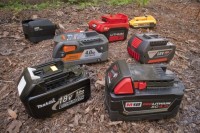 Having tested several 12V models, the problem with cordless multi-tools has always been that you’re constantly (it seems) reaching for a new battery.
Having tested several 12V models, the problem with cordless multi-tools has always been that you’re constantly (it seems) reaching for a new battery.
I can safely announce that those days are over. There is, in my mind, really no reason to purchase a corded multi-tool if you’re not working in a shop where you need absolute constant run-time (or to reduce the tool weight as much as possible).
The best cordless oscillating multi-tools can go for a very long time.
I operated the tool with no-load, but I made sure to use each tool to cut roughly 22-inches of 3/4″ heart pine as well as 17.5″ of 2×4 material.
This gave the tool some load during the test so it wasn’t purely an idle speed battery comparison.
The results were somewhat surprising.
I expected the 4Ah batteries to win hands-down, but the 3.0Ah Makita lasted 50 minutes and 23 seconds before it shut off, besting even the 4.0Ah Milwaukee by almost 16 minutes!
To sweeten the pot, it only takes 30 minutes to recharge the Makita before it’s ready to go again.
The Ridgid JobMax, however, ran for an astounding 1 hour and 45 minutes (and 43 seconds). It ran so long, I don’t ever want to do another run-time test in my life. It was like the energizer bunny … except orange … and with bigger teeth.
The next closest contender was the Porter-Cable which ran for over 1 hour and 14 minutes. The DeWalt gave indeterminate results as its protection mode kicked in at around 10 minutes … then again 5 minutes later.
I doubt you’ll run an oscillating multi-tool continuously that long, so it’s hard to fault them.
Test 5: Noise Levels
Given OSHA’s rules on occupational noise exposure in the workplace, testing the multi-tools for maximum sound output seemed like a good idea.
There weren’t too many surprises here, with all tools falling into a range from 88dB to 93 dB SPL.
This means that when measured from 36″ away, the tool is capable of emitting this level of noise when measured with an SPL meter using C-weighting (we set it to slow response to ensure the output we were hearing was sustained).
Overall, the quietest tools were the Porter-Cable PCC710 (87 dB), the Ridgid JobMax (88 dB), and the Bosch MXH180BL (89 dB).
The loudest tools were the DeWalt DCS355, Milwaukee 2626-20, and Fein MultiMaster AFMM 14 (all three measured 93 dB SPL).
My general recommendation is that if you plan on using these tools, you should don protective earmuffs or plugs.
Conclusion
Which multi-tool you choose will depend a lot upon what your needs are, but I couldn’t help but be blown away by the Makita LXMT025. It had excellent run-time, a fast cutting speed and great ergonomics. It also had the least vibration of all tools tested and the fastest charge time for an 18V battery. This is simply a great tool.
In ergonomics, the best cordless oscillating multi-tools were the Makita LXMT025, Bosch MXH180BL and Porter-Cable 18V PCCK510LA, as they were the most easy to use. They also exhibited the least vibration, channeling all of the cutting effort into the work piece—and not your hand.
I also loved the refinement of the Fein AFMM 14 MultiMaster, particularly in how well put-together the tool is and its overall build quality—which is superb (but you’ll pay for it).
The Bosch MXH180BL and the DeWalt DCS355 are the only brushless multi tools on the market I’m aware of, and the Bosch in particular just feels like a solid machine that will last forever.
If any tool went directly after Fein’s “Mercedes level” design methodology it was the MHX180BL.
In terms of sheer value, it will be hard to beat picking up the Porter-Cable PCC710 if you’ve already bought into the 20V Max system. For $69 you get a tool that can get the job done.
Of course, for around $199 you can get the brushless DeWalt DCS355D1 kit that includes a 20V Max slim battery and charger and was very comfortable to use—a tough bargain to beat!
Tool by Tool
Bosch MXH180BL
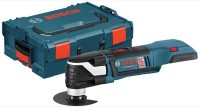 The Bosch came across as a very well-built, but very squared-off tool that feels extra large in the hand—a trait I don’t view as an asset for comfort.
The Bosch came across as a very well-built, but very squared-off tool that feels extra large in the hand—a trait I don’t view as an asset for comfort.
It is one of only two brushless models (the other is the DeWalt DCS355D1) and it has one of the easiest accessory/blade changes on the market.
It uses a “spreader” instead of a retaining pin or threaded rod. The result is that this is the fastest tool for changing out blades. I would even go head-to head with Porter-Cable’s clamp system with this one.
There’s no LED on tis tool, so bear that in mind if you tend to work in dimply-lit locations.
- Pros: Brushless, well-built, fastest/easiest accessory change, fast-cutting
- Cons: No LED, bulky and heavy, expensive, sold without battery or charger
- Price: $329
Verdict: This is a Mercedes-Benz multi-tool that prices itself like a Volkswagen and looks like a Volvo.
Fein AFMM 14 MultiMaster
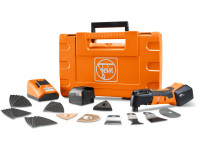 The Fein is the second-fastest tool in the bunch, losing only to the Makita.
The Fein is the second-fastest tool in the bunch, losing only to the Makita.
Short in length, it’s super easy to guide and use.
It’s also a pleasure to hold in the hand, with smooth edges, but a nice sturdy grip.
The tool-less blade release is tough to operate at first, but once you get used to it you can change out accessories lightning quick.
Expect to pay over $150 more than any other multi-tool in the group.
- Pros: Built like a tank, easy/quick accessory change, nicely balanced, fast-cutting
- Cons: No LED, very expensive, loud
- Price: $499
Verdict: If you want the most expensive well-built cordless multi-tool you can buy, this is it.
Makita LXMT025
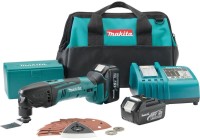 I don’t want to insult Makita by saying I was surprised by how good this tool was, but it clearly blew away our team during the testing.
I don’t want to insult Makita by saying I was surprised by how good this tool was, but it clearly blew away our team during the testing.
The Makita LXMT025 has roughly half the vibration of most other tools and is almost a pleasure to work with.
It has a long run-time and charges the battery in less time than any other 18V tool (which is good because the company refuses to add a battery level meter to its tools).
With the fastest cutting speed of all tools tested, this tool was our overall leader.
It’s also one of four tools that can stand upright (the others are the Porter-Cable PCCK510, the 20V Max PCC710 and the DeWalt DCS355).
- Pros: Fast cutting, low vibration, quick charge time
- Cons: No battery level meter.
- Price: $299
Verdict: The overall leader in our testing … there’s just no other way to say it.
Milwaukee 2626-22
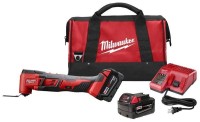 The Milwaukee 2626-20 is a solid tool with great ergonomics.
The Milwaukee 2626-20 is a solid tool with great ergonomics.
It’s easy to maneuver and the blade change mechanism is simple to use, though it requires unscrewing the retaining bolt.
This tool has a lot of vibration compared to some of the others, and we were surprised by its slower cutting speed and the run-time performance.
It’s also a very long tool, measuring 16-1/2″ off the blade (second only to the Ridgid which is nearly 17″ long. T
he Milwaukee runs very hot, and the blade and retaining ring heat up significantly during use.
- Pros: Nice ergonomic feel, quick accessory change
- Cons: Slow and has a lot of vibration, mediocre run-time
- Price: $299
Verdict: A decent choice for those who are already on Milwaukee’s M18 platform, but there are better choices for someone looking for a top-performing multi-tool.
Porter-Cable PCCK510LA
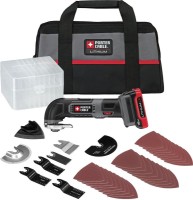 This tool is still sold alongside the newer 20V Max model, but it has some definite flaws.
This tool is still sold alongside the newer 20V Max model, but it has some definite flaws.
It’s very heavy toward the rear of the tool, so it wants to lean back on you during use.
While tool-less accessory system is nice, you’ll end up using a tool if you want to go for any non-Porter-Cable (OIS) accessories.
I also found it really odd that the tool didn’t clamp flush to most accessories—including Porter-Cable’s own.
The LED Light is perfectly placed on the work area and it’s great that the tool stands upright (albeit with a dramatic backward lean).
- Pros: Inexpensive, well-placed LED, stands vertical
- Cons: No battery level meter, awkward balance
- Price: $129
Verdict: This is an average multi-tool that you can pickup for cheap and use on just about anything.
Porter-Cable PCC710B 20V Max
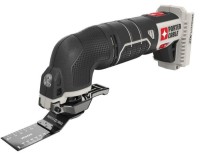 The 20V Max version of the Porter-Cable oscillating multi-tool improves a bit on the former model, like losing the dramatic backward lean (it now stands straight, perpendicular to the battery).
The 20V Max version of the Porter-Cable oscillating multi-tool improves a bit on the former model, like losing the dramatic backward lean (it now stands straight, perpendicular to the battery).
Other than that you get a new outer shell, and the power switch has been moved toward the bottom of the handle to let you choke up on the tool if desired.
Because of this and a nice finger detent near the top, this tool feels very nimble in the hand.
The grip would be awesome for a jigsaw as you almost want to try out some curved cuts!
- Pros: Excellent ergonomics, super-inexpensive
- Cons: Slowest cutting tool, intense vibration, awkward switch position
- Price: $69
Verdict: If you have any Porter-Cable 20V Max tools, you’d be crazy not to pick this up as it’s priced at less than $70.
Ridgid JobMax R862004
 Because it’s built on the JobMax platform, the R862004 (along with the DeWalt DCS355D1) uses a variable speed trigger in lieu of a fixed speed dial.
Because it’s built on the JobMax platform, the R862004 (along with the DeWalt DCS355D1) uses a variable speed trigger in lieu of a fixed speed dial.
The LED light is optimized for JobMax’ driving tools more than this head.
The ergonomics of this tool are excellent, and it has the narrowest and most comfortable handle of all of the tools tested (save, perhaps, the DeWalt).
The run-time on this tool was a mind-blowing 1 hour and 45 minutes!
- Pros: Unbelievable run-time, fast cutting, excellent ergonomics, great value
- Cons: No variable speed dial, no kit option
- Price: $219
Verdict: This is an all-around great tool that can also be used with Ridgid’s other JobMax heads (right angle drill, impact driver, recip saw, jig saw, etc.)
DeWalt DCS355D1 20V Max
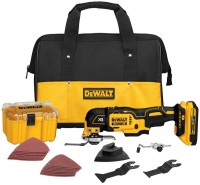 The DeWalt DCS355D1 is the only other brushless tool on the market, but it feels like the Ridgid JobMax had an affair with Porter-Cable and produced an offspring even more capable than the parents.
The DeWalt DCS355D1 is the only other brushless tool on the market, but it feels like the Ridgid JobMax had an affair with Porter-Cable and produced an offspring even more capable than the parents.
We loved the cutting speed, the handling and the included accessory for setting your depth of cut.
The brushless motor (the only other tool advertising an EC motor is the Bosch MXH180BL) means that you should be able to get many years of use out of this tool.
- Pros: Aggressive cutting, brushless motor, perfect ergonomics, excellent value
- Cons: No variable speed dial, loud, overzealous protection mode
- Price: $199
Verdict: Priced $100 or more under most other kits, DeWalt is going after the remaining market with this impressive brushless tool.
—This article is reprinted with permission from ProToolReviews.com, an excellent source of tool reviews (as the name implies). Clint DeBoer, the Editor-in-chief, wrote this piece.
